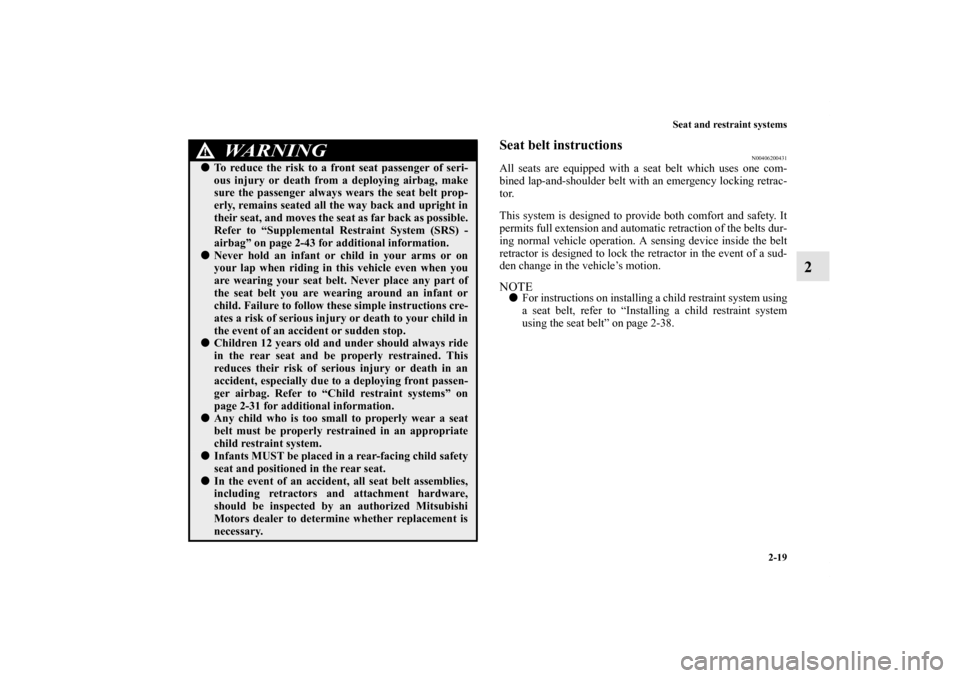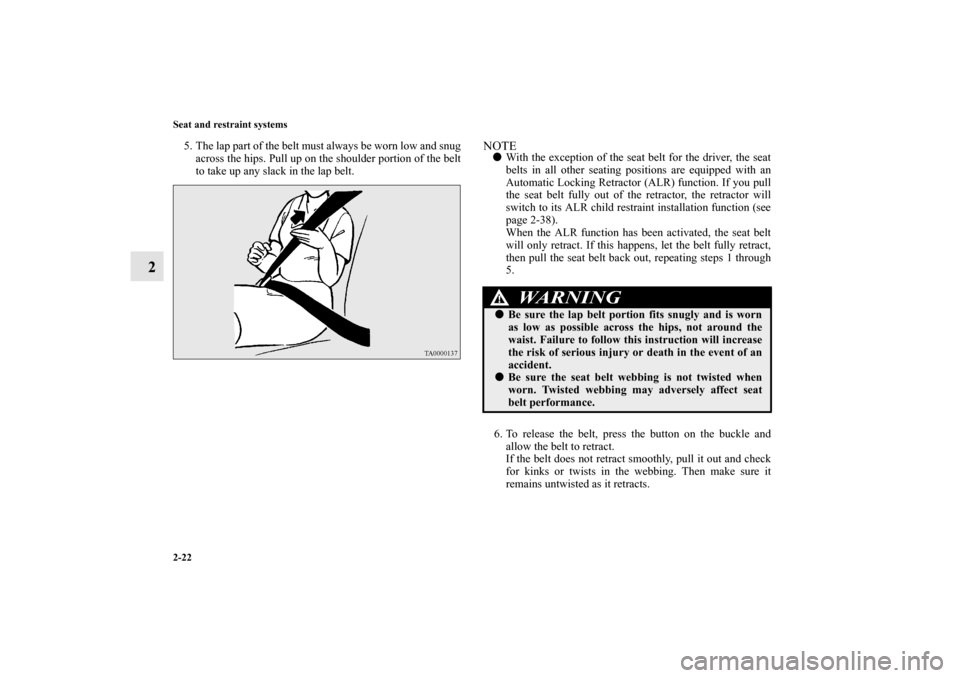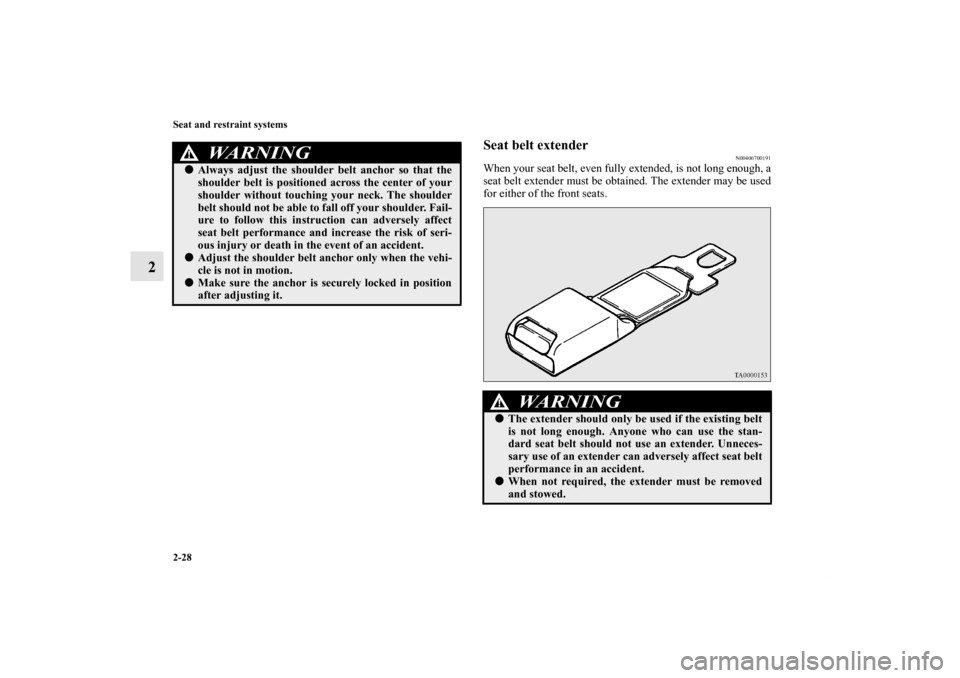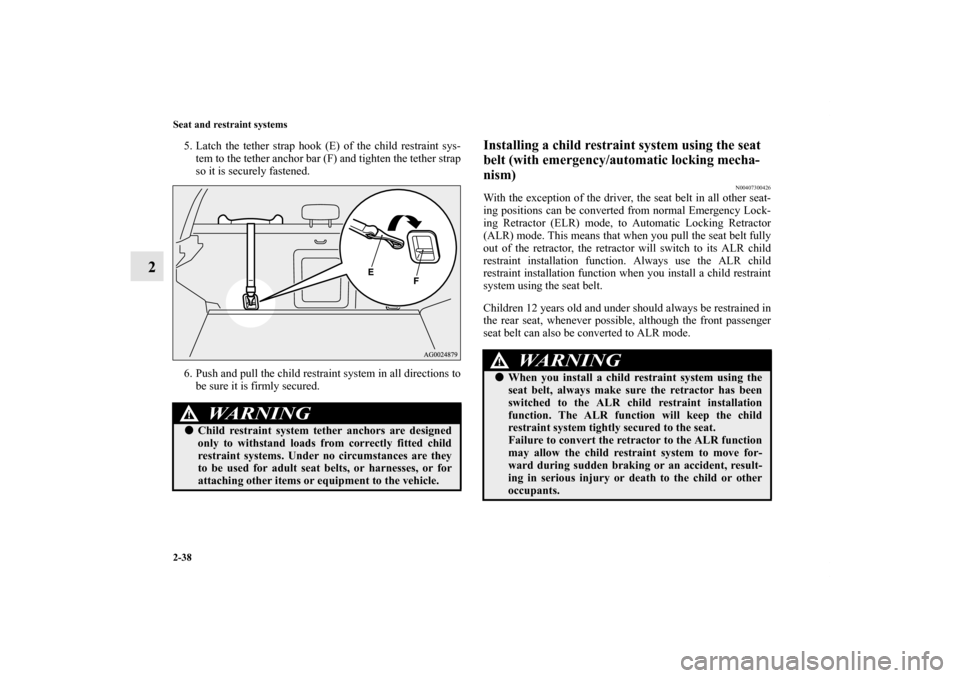Page 46 of 602

Seat and restraint systems
2-19
2
Seat belt instructions
N00406200431
All seats are equipped with a seat belt which uses one com-
bined lap-and-shoulder belt with an emergency locking retrac-
tor.
This system is designed to provide both comfort and safety. It
permits full extension and automatic retraction of the belts dur-
ing normal vehicle operation. A sensing device inside the belt
retractor is designed to lock the retractor in the event of a sud-
den change in the vehicle’s motion.NOTE�For instructions on installing a child restraint system using
a seat belt, refer to “Installing a child restraint system
using the seat belt” on page 2-38.
�To reduce the risk to a front seat passenger of seri-
ous injury or death from a deploying airbag, make
sure the passenger always wears the seat belt prop-
erly, remains seated all the way back and upright in
their seat, and moves the seat as far back as possible.
Refer to “Supplemental Restraint System (SRS) -
airbag” on page 2-43 for additional information.�Never hold an infant or child in your arms or on
your lap when riding in this vehicle even when you
are wearing your seat belt. Never place any part of
the seat belt you are wearing around an infant or
child. Failure to follow these simple instructions cre-
ates a risk of serious injury or death to your child in
the event of an accident or sudden stop.�Children 12 years old and under should always ride
in the rear seat and be properly restrained. This
reduces their risk of serious injury or death in an
accident, especially due to a deploying front passen-
ger airbag. Refer to “Child restraint systems” on
page 2-31 for additional information.�Any child who is too small to properly wear a seat
belt must be properly restrained in an appropriate
child restraint system.�Infants MUST be placed in a rear-facing child safety
seat and positioned in the rear seat.�In the event of an accident, all seat belt assemblies,
including retractors and attachment hardware,
should be inspected by an authorized Mitsubishi
Motors dealer to determine whether replacement is
necessary.
WA R N I N G
!
BK0120400US.book 19 ページ 2010年5月12日 水曜日 午前10時50分
Page 48 of 602
Seat and restraint systems
2-21
2
2. Before using the rear center seat belt, make sure that the
detachable anchor is securely latched and the seat belt is
not twisted. For details, refer to page 2-23.
3. Grasp the latch plate and slide it up the webbing so that it
easily pulls across your body. 4. Pull the seat belt out slowly while holding the latch plate.
Push the latch plate into the buckle until you hear a
“click”. Pull up on the belt to be sure the latch plate is
locked securely in the buckle.
NOTE�If the seat belt locks up and cannot be pulled out, pull it
once with force and let it retract all the way.
Then, pull the belt out slowly once again.
BK0120400US.book 21 ページ 2010年5月12日 水曜日 午前10時50分
Page 49 of 602

2-22 Seat and restraint systems
2
5. The lap part of the belt must always be worn low and snug
across the hips. Pull up on the shoulder portion of the belt
to take up any slack in the lap belt.
NOTE�With the exception of the seat belt for the driver, the seat
belts in all other seating positions are equipped with an
Automatic Locking Retractor (ALR) function. If you pull
the seat belt fully out of the retractor, the retractor will
switch to its ALR child restraint installation function (see
page 2-38).
When the ALR function has been activated, the seat belt
will only retract. If this happens, let the belt fully retract,
then pull the seat belt back out, repeating steps 1 through
5.
6. To release the belt, press the button on the buckle and
allow the belt to retract.
If the belt does not retract smoothly, pull it out and check
for kinks or twists in the webbing. Then make sure it
remains untwisted as it retracts.
WA R N I N G
!�Be sure the lap belt portion fits snugly and is worn
as low as possible across the hips, not around the
waist. Failure to follow this instruction will increase
the risk of serious injury or death in the event of an
accident.�Be sure the seat belt webbing is not twisted when
worn. Twisted webbing may adversely affect seat
belt performance.
BK0120400US.book 22 ページ 2010年5月12日 水曜日 午前10時50分
Page 50 of 602
Seat and restraint systems
2-23
2
Detachable rear center seat belt
N00409700017
The rear center seat belt can be detached to help avoid damage
caused by an object in the luggage compartment while the
driver’s side rear seat back is folded down.To a t t a c h
1. Pull the seat belt out slowly and pass it through the seat
belt guide (A).
NOTE�If the seat belt locks up and cannot be pulled out, pull it
once with force and let it retract all the way.
Then, pull the belt out slowly once again.
WA R N I N G
!�Never detach the rear center seat belt except when
the driver’s side rear seat back is folded down.
Using the rear center seat belt with the detachable
anchor unlatched increases the risk of serious injury
or death in an accident. Make sure the detachable
anchor is properly latched before the center seat belt
is used.
BK0120400US.book 23 ページ 2010年5月12日 水曜日 午前10時50分
Page 54 of 602
Seat and restraint systems
2-27
2
Front passenger seat belt warning light
N00418300194
The front passenger seat belt warning light is located in the
instrument panel.
When the ignition switch is turned to the “ON” position or the
operation mode is put in ON, this indicator normally comes on
and goes off a few seconds later.
The light comes on when a person sits on the front passenger
seat but does not fasten the seat belt. It goes off when the seat
belt is subsequently fastened.
Adjustable seat belt shoulder anchor (front seats)
N00406300302
To move the anchor (A), press the lock knob (B) and slide the
anchor to the desired position.
WA R N I N G
!�Do not install any accessory or sticker that makes
the light difficult to see.
Anchor down Anchor up
BK0120400US.book 27 ページ 2010年5月12日 水曜日 午前10時50分
Page 55 of 602

2-28 Seat and restraint systems
2
Seat belt extender
N00406700191
When your seat belt, even fully extended, is not long enough, a
seat belt extender must be obtained. The extender may be used
for either of the front seats.
WA R N I N G
!�Always adjust the shoulder belt anchor so that the
shoulder belt is positioned across the center of your
shoulder without touching your neck. The shoulder
belt should not be able to fall off your shoulder. Fail-
ure to follow this instruction can adversely affect
seat belt performance and increase the risk of seri-
ous injury or death in the event of an accident.�Adjust the shoulder belt anchor only when the vehi-
cle is not in motion.�Make sure the anchor is securely locked in position
after adjusting it.
WA R N I N G
!�The extender should only be used if the existing belt
is not long enough. Anyone who can use the stan-
dard seat belt should not use an extender. Unneces-
sary use of an extender can adversely affect seat belt
performance in an accident.�When not required, the extender must be removed
and stowed.
BK0120400US.book 28 ページ 2010年5月12日 水曜日 午前10時50分
Page 65 of 602

2-38 Seat and restraint systems
2
5. Latch the tether strap hook (E) of the child restraint sys-
tem to the tether anchor bar (F) and tighten the tether strap
so it is securely fastened.
6. Push and pull the child restraint system in all directions to
be sure it is firmly secured.
Installing a child restraint system using the seat
belt (with emergency/automatic locking mecha-
nism)
N00407300426
With the exception of the driver, the seat belt in all other seat-
ing positions can be converted from normal Emergency Lock-
ing Retractor (ELR) mode, to Automatic Locking Retractor
(ALR) mode. This means that when you pull the seat belt fully
out of the retractor, the retractor will switch to its ALR child
restraint installation function. Always use the ALR child
restraint installation function when you install a child restraint
system using the seat belt.
Children 12 years old and under should always be restrained in
the rear seat, whenever possible, although the front passenger
seat belt can also be converted to ALR mode.
WA R N I N G
!�Child restraint system tether anchors are designed
only to withstand loads from correctly fitted child
restraint systems. Under no circumstances are they
to be used for adult seat belts, or harnesses, or for
attaching other items or equipment to the vehicle.
WA R N I N G
!�When you install a child restraint system using the
seat belt, always make sure the retractor has been
switched to the ALR child restraint installation
function. The ALR function will keep the child
restraint system tightly secured to the seat.
Failure to convert the retractor to the ALR function
may allow the child restraint system to move for-
ward during sudden braking or an accident, result-
ing in serious injury or death to the child or other
occupants.
BK0120400US.book 38 ページ 2010年5月12日 水曜日 午前10時50分
Page 67 of 602
2-40 Seat and restraint systems
2
3. To activate the ALR child restraint installation function,
slowly pull the shoulder part of the belt all the way out of
the retractor until it stops. Then let the belt feed back into
the retractor.
4. After the belt has retracted, tug on it.
If the belt is in the ALR function, you will not be able to
pull it out. If the webbing can be pulled out from retractor,
the ALR function has not been activated and you will
need to repeat steps 3 and 4.5. After confirming that the belt is locked, grab the shoulder
part of the belt near the buckle and pull up to remove any
slack from the lap part of the belt allowing the slack to
feed into the retractor. Remember, if the lap belt portion is
not tight, the child restraint system will not be secure. It
may help to put your weight on the child restraint system
and/or push on its seatback while pulling up on the belt
(See illustration).
BK0120400US.book 40 ページ 2010年5月12日 水曜日 午前10時50分